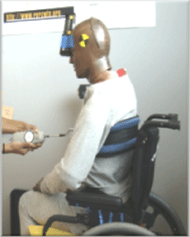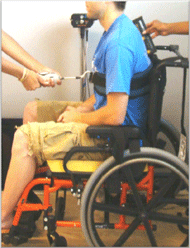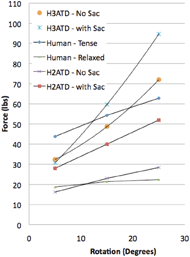SELECTING AN ANTHROPOMORPHIC TEST DEVICE FOR LOW ACCELERATION WHEELCHAIR TRANSPORTATION TESTING
Linda van Roosmalen PhD, Michael Turkovich PhD, Patricia Karg MSE
Dept. of Rehabilitation Science & Technology and Dept. of Bioengineering University of Pittsburgh, Pittsburgh, PA
ABSTRACT
To investigate wheelchair occupant injury risk during low-speed travel in large vehicles, Anthropomorphic Test Devices (ATDs) developed for high impact crash conditions are commonly used. However, in low-acceleration conditions ATDs do not perform the same way as a wheelchair seated individual, due to a higher stiffness in the ATD spine and joints. This study measured the horizontal (semi- static) pull force associated with forward ATD torso rotation and compared it to the pull force in seated human volunteers. Results indicate that a Hybrid II ATD (H2ATD) and a Hybrid III ATD (H3ATD) with an abdominal sac in place and a H3ATD without an abdominal sac, display significantly higher pull forces to acquire forward torso rotation angles of 15 degrees and higher when compared to seated human volunteers. However, a H2ATD without an abdominal sac displays very similar average pull forces for all torso rotation angles when compared to relaxed seated human volunteers.
We conclude that between H2 and H3ATDs, a H2ATD without an abdominal sac is more appropriate for use in low acceleration studies when evaluating wheelchair occupant kinematics in low acceleration vehicle environments.
KEYWORDS
Anthropomorphic Test Device, low acceleration, injury, wheelchair transportation safety, wheelchair fall, braking.
INTRODUCTION
Recent data from 2005 and 2006 suggests there are between 1.6 and 2.2 million Americans that rely on wheelchairs to assist with mobility either occasionally or permanently (Xiang, 2006). Because of this large number of wheelchair users, it is likely that the number of national, annual wheelchair accidents has risen significantly above the most recent report of 36,000 incidents in 1990 (Ummat, 1994).
To investigate wheelchair occupant risk of injury during normal wheelchair travel or when wheelchair occupants ride in a slow moving vehicle, it is not always ethical or practical to use human research subjects in testing. Therefore, there is a need to find an appropriate substitute that would perform similar to an actual human test subject even during low-acceleration dynamic test scenarios.
Low acceleration forces less than 1g have been measured inside large public transit vehicles during non-crash maneuvers such as braking and turning. And H2ATDs and H3ATDs are common mechanical surrogates used to represent human subjects in high-acceleration impact testing. The H3ATD differs from the H2 in that it better mimics human neck bending in response to flexion and extension in high impact testing (Mertz, 1993). It also seems that under non-dynamic conditions a H3ATD is stiffer in the spine region. Both ATDs have been used in low acceleration tests (Cooper, 1998; Dvorznak, 2001; Ummat, 1994; Sosner 1997). Dvorznak et al. used a modified H2ATD to evaluate the kinematics of wheelchair-seated occupants with a spinal cord injury during wheelchair braking (Dvorznak, 2001) to evaluate falls from wheelchairs. The H2ATD was modified by: removing its abdominal sac and adjusting and lubricating the bolts at the hip joints to represent individuals with lower extremity paralysis. A standard H2ATD showed less movement when compared to the test pilot (an individual with T8 spinal cord injury). The modified H2ATD had less trunk stability than a standard H2 during all tests. The researchers concluded that a modified H2ATD can represent a wheelchair user with a spinal cord injury. Figure 1 shows the averages of trunk angular acceleration curves of the test pilot (individual with lower extremity paralysis), a modified and standard H2ATD during reverse joystick braking in a powered wheelchair (Dvorznak, 2001).
 Figure 1: Comparison of a test pilot, modified H2ATD and standard H2ATD (Dvorznak, 2001). d
Figure 1: Comparison of a test pilot, modified H2ATD and standard H2ATD (Dvorznak, 2001). dDvorznak also used the H3ATD to investigate its bioequivalence with a wheelchair user during kinematic (wheelchair brake) testing at low accelerations (Dvorznak, 2005). A H3ATD with a pedestrian pelvis was used to conduct this study. Although the investigators found mixed results they concluded that a H3ATD is also a suitable surrogate for a wheelchair occupant in low-speed, low-impact wheelchair studies.
Injuries to wheelchair users riding in vehicles commonly occur due to sudden vehicle braking causing forward torso rotation and occupant impact with the vehicle interior and floor. Selecting an ATD that has comparable occupant kinematics during low decelerations (vehicle braking) is important when evaluating the effectiveness of novel occupant restraint systems designed for low-acceleration conditions. Unpublished non-impact, low- acceleration testing done by the RERC on Wheelchair Transportation Safety has shown that a H3ATD may be too stiff to use in low acceleration braking conditions. To understand the difference between a H2 and H3ATD in low acceleration conditions a horizontal pull force test was proposed to collect and compare semi- static forces associated with forward torso rotations of H2ATD, H3ATD and human volunteers.
OBJECTIVE
 Figure 2: A Hybrid 2 ATD without (left) and with (right) the abdominal section in place. d
Figure 2: A Hybrid 2 ATD without (left) and with (right) the abdominal section in place. dThe aim of this study was to select an appropriate test device that most closely represents a wheelchair-seated relaxed occupant exposed to low-acceleration forces.
METHODS
The following pull test scenarios were completed with a H2ATD, a H3ATD and four male volunteers to determine which of the ATDs showed pull forces that were similar to those of a seated person:
- H2ATD without an abdominal sac
- H2ATD with an abdominal sac
- H3ATD without an abdominal sac
- H3ATD with an abdominal sac
- Person with tense back muscles
- Person with relaxed back muscles
 Figure 3 (left): The ATD is positioned and prepared with an inclinometer strapped to the head. d
Figure 3 (left): The ATD is positioned and prepared with an inclinometer strapped to the head. dFirst a H2ATD, having its abdominal sac removed (Figure 2, left), was placed in a standard manual wheelchair and stabilized with a wheelchair securement system. The wheelchair had a sling seat surface with arm- and footrests. The ATD was restrained in the wheelchair using a wheelchair-integrated lap belt. A chest strap was routed under the arms and tightened around the ATD chest (Figure 3). The arms of the ATD were placed on the wheelchair armrests. An inclinometer secured to the ATD head was used to measure change in upper-body angle during the pull test. The pre-test angle was recorded. A manual force gauge was hooked to the chest harness and a slow, horizontal force was manually applied to the force gauge handle to rotate the ATD torso forward. Separate tests were performed for each angle. The pull force to move the torso 5, 15 and 25 degrees relative to the vertical was recorded. The pull test was performed three times for each scenario and each angle and an average measurement was calculated for each angle.
 Figure 4 (right): Person setup in the test wheelchair with the force gauge applied. d
Figure 4 (right): Person setup in the test wheelchair with the force gauge applied. dThe same test was performed with a H2ATD with an abdominal sac (test 2, Figure 2, right), a H3ATD with and without abdominal sac (test 3 and 4) and with four male participants (Figure 4). The four male participants were selected to represent a male in close proximity to the height and weight of the ATDs. Subjects were within 20 lb. of the ATD weight (187 lb.) and were within 1 inch of the ATD height (69 in.).
To simulate individuals with and without upper trunk stability, participants were instructed to remain seated with their eyes closed during the pull tests and to keep their back muscles tensed (but refrain from using the lower body) during one pull force test (test #5) and to relax all back muscles while another pull test was performed (test #6). Data from individual trials was averaged, and tabulated using Microsoft Excel.
RESULTS
|
Average Pull Forces (lbs) | |||
|---|---|---|---|---|
| Test Scenario | 5 Deg | 15 Deg | 25 Deg | Total Avg |
| 1. H2: No Abdomen | 16.2 | 23.0 | 28.4 | 22.5 |
| 2. H2: With Abdomen | 28.0 | 40.0 | 52.0 | 40.0 |
| 3. H3: No Abdomen | 32.3 | 48.7 | 72.0 | 51.0 |
| 4. H3: With Abdomen | 30.8 | 59.7 | 94.7 | 61.7 |
| 5. Human Tense | 43.9 | 54.3 | 62.8 | 53.7 |
| 6. Human Relaxed | 18.7 | 21.4 | 22.4 | 20.8 |
Average pull forces from the six test scenarios are listed in Table 1. The results indicate that the H2ATD without the abdominal sac shows an average force of 16.2 lbs to rotate the upper torso 5 degrees forward, 23.0 lbs of force to move the torso 15 degrees, and 28.4 lbs of force to move the torso 25 degrees forward. The H2ATD with the abdominal sac shows an average force of 28.0 lbs at 5 degrees, 40.0 lbs at 15 degrees, and 52.0 lbs at 25 degrees. The H3ATD without the abdominal sac shows an average force of 32.3 lbs at 5 degrees, 48.7 lbs at 15 degrees, and 72.0 lbs at 25 degrees. The H3ATD with the abdominal sac shows an average force of 30.8 lbs at 5 degrees, 59.7 lbs at 15 degrees and 94.7 lbs at 25 degrees. The average force required to rotate the upper torso of relaxed volunteers forward was 18.7 lbs at 5 degrees, 21.4 lbs at 15 degrees, and 22.4 lbs at a 25 degree forward upper torso angle. The average force required to rotate the upper torso forward of tensed volunteers was 43.9 lbs to rotate 5 degrees, 54.3 lbs for 15 degrees, and 62.8 lbs for 25 degrees of upper torso rotation.
 Figure 5: Average force versus torso rotation for the different test scenarios d
Figure 5: Average force versus torso rotation for the different test scenarios dFigure 5 shows a comparison of the average values of the six pull tests. The force versus rotation of a relaxed human volunteer was taken as the base-line in this study because it best represents a wheelchair user with limited upper trunk stability that is unable to use his/her lower back muscles and lacks the ability to react to external (deceleration) forces (Minkel 2000).
CONCLUSION
Results from this study indicate that a H2ATD and H3ATD with an abdominal sac and H3ATD without an abdominal sac display significantly higher forces to acquire forward torso rotation angles of 15 degrees and higher when compared to a relaxed human volunteer.
Under low acceleration conditions these ATDs will not closely represent the kinematics of a person with limited upper trunk stability and may therefore overestimate or underestimate the safety of restraint systems. On the contrary, the H2ATD without an abdominal sac displays a similar average pull force when compared to the relaxed human volunteers. An H2ATD will better represent the kinematics of a person with limited upper trunk stability and can be used to evaluate the performance of restraint systems designed for use in low-acceleration environments by individuals seated in wheelchairs.
Note that this study did not account for the postural differences between able-bodied individuals and those with disabilities (Hobson, 1992).
Future studies should further investigate the kinematics of ATDs and how injury criteria set for high impact crash conditions can be translated for use in low-acceleration environments.
REFERENCES
Cooper, R. A., M. J. Dvorznak, et al. (1998). "Braking electric-powered wheelchairs: Effect of braking method, seatbelt, and legrests." Archives of Physical Medicine and Rehabilitation 79(10): 1244-1249.
Dvorznak, M. J., R. A. Cooper, et al. (2005). "Kinematic analysis for determination of bioequivalence of a modified Hybrid III test dummy and a wheelchair user." Journal of Rehabilitation Research and Development 42(3): 343-352.
Dvorznak, M. J., R. A. Cooper, et al. (2001). "Kinematic comparison of Hybrid II test dummy to wheelchair user." Medical Engineering and Physics 23: 239-247.
Hobson, D. A. and R. E. Tooms (1992). "Seated lumbar/pelvic alignment: a comparison between spinal cord-injured and noninjured groups." Spine 17(3): 293. Mertz, H. (1993). Anthropomorphic test devices. Accidental Injury: Biomechanics and Prevention. D. Nahum and J. Melvin: 66-84.
Minkel, J. L. (2000). "Seating and mobility considerations for people with spinal cord injury." Physical Therapy 80(7): 701.
Sosner, J., A. Fast, et al. (1997). "Forces, moments and accelerations acting on an unrestrainted dummy during simulations of three wheelchair accidents." American journal of Physical Medicine and Rehabilitation 76(4): 304.
Ummat, S. and R. L. Kirby (1994). "Nonfatal Wheelchair Related Accidents Reported to the National Electronic Injury Surveillance system." American Journal of Physical Medicine and Rehabilitation 73(3): 163-167.
Xiang, H., A. M. Chany, et al. (2006). "Wheelchair related injuries treated in US emergency departments." Injury Prevention 12(1): 8.
ACKNOWLEDGEMENTS
This study was funded by the National Institute on Disability and Rehabilitation Research Rehabilitation Engineering Research Center on Wheelchair Transportation Safety grant #H133E060064. The authors wish to thank the University of Michigan Transportation Research Institute for loaning the H2 and H3 ATDs for use in this study.
CONTACT
For additional information contact Linda van Roosmalen: info@lincdesign.biz ;412.401.8194.